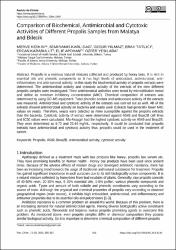| dc.contributor.author | Keskin, Merve | |
| dc.contributor.author | Karlıdağ, Semiramis | |
| dc.contributor.author | Yılmaz, Özgür | |
| dc.contributor.author | Tatlıcı, Eray | |
| dc.contributor.author | Karabulut, Ercan | |
| dc.contributor.author | Apohan, Elif | |
| dc.contributor.author | Yeşilada, Özfer | |
| dc.date.accessioned | 2021-06-14T06:58:01Z | |
| dc.date.available | 2021-06-14T06:58:01Z | |
| dc.date.issued | 2020 | en_US |
| dc.identifier.citation | Keskin, M., Karlıdağ, S., Apohan, E., Yılmaz, O., Tatlıcı, E., Apohan, E., Yesilada, O., ... Karabulut, E. (January 01, 2020). Comparison of biochemical, antimicrobial and cytotoxic activities of different propolis samples from Malatya and Bilecik. Revista De Chimie, 71, 5, 355-362. | en_US |
| dc.identifier.issn | 2668-8212 | |
| dc.identifier.issn | 0034-7752 | |
| dc.identifier.uri | https://doi.org/10.37358/RC.20.5.8144 | |
| dc.identifier.uri | https://hdl.handle.net/20.500.12899/243 | |
| dc.description.abstract | Propolis is a resinous natural mixtures collected and produced by honey bees. It is rich in essential oils and phenolic components so it has high levels of antioxidant, antimicrobial, anti-inflammatory and anti-tumoral activity. In this study the biochemical activity of propolis extracts were determined. The antimicrobial activity and cytotoxic activity of the extracts of the nine different propolis samples were invastigated. Their antimicrobial activities were tested by microdillution metod and define as minimum inhibitory concentration (MIC). Chemical composition of extracts was determined by using GC-MS equipment. Total phenolic content and antioxidant activity of the extracts was measured. Antimicrobial and cytotoxic activity of the extracts was carried out as well. All of the extracts showed antimicrobial activity on bacteria and yeasts used. Extracts had generally lower MIC values on yeasts. Therefore, yeasts were detected as more susceptible against the propolis extracts than the bacteria. Cytotoxic activity of extract were determined aganist A549 and Beas2B cell lines and IC50 values were calculated. Ma-Arapgir had the highest cytotoxic activity on A549 and Beas2B. They were determined as 6.72 and 26.44 mg/mL, respectively. It could be concluded that propolis extracts have antimicrobial and cytotoxic activity thus, propolis could be used in the treatment of cancer. © 2020 SYSCOM 18 S.R.L.. All rights reserved. | en_US |
| dc.language.iso | eng | en_US |
| dc.publisher | Revista de Chimie SRL | en_US |
| dc.relation.isversionof | 10.37358/RC.20.5.8144 | en_US |
| dc.rights | info:eu-repo/semantics/openAccess | en_US |
| dc.subject | Propolis | en_US |
| dc.subject | A549 | en_US |
| dc.subject | Beas2B | en_US |
| dc.subject | Antimicrobial activity | en_US |
| dc.subject | Cytotoxic activity | en_US |
| dc.title | Comparison of biochemical, antimicrobial and cytotoxic activities of different propolis samples from Malatya and Bilecik | en_US |
| dc.type | article | en_US |
| dc.authorid | 0000-0002-5997-2061 | en_US |
| dc.department | MTÖ Üniversitesi, Akçadağ Meslek Yüksekokulu, Bitkisel ve Hayvansal Üretim Bölümü | en_US |
| dc.contributor.institutionauthor | Karlıdağ, Semiramis | |
| dc.identifier.volume | 71 | en_US |
| dc.identifier.issue | 5 | en_US |
| dc.identifier.startpage | 355 | en_US |
| dc.identifier.endpage | 362 | en_US |
| dc.relation.journal | Revista de Chimie | en_US |
| dc.relation.publicationcategory | Makale - Uluslararası Hakemli Dergi - Kurum Öğretim Elemanı | en_US |


















